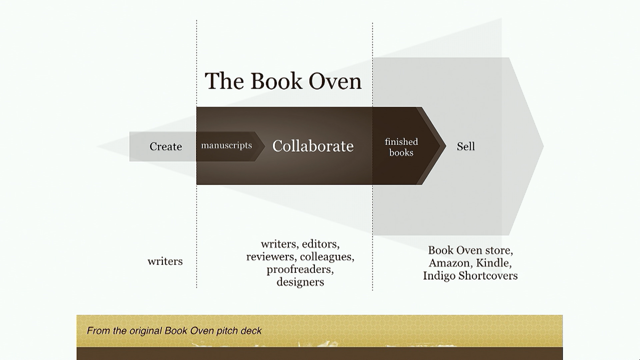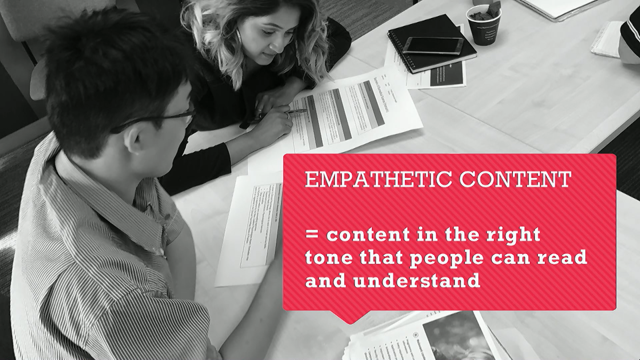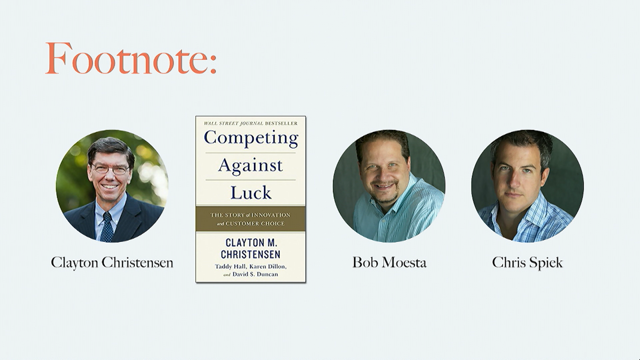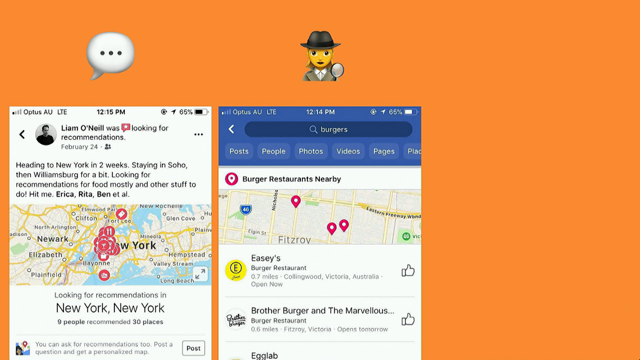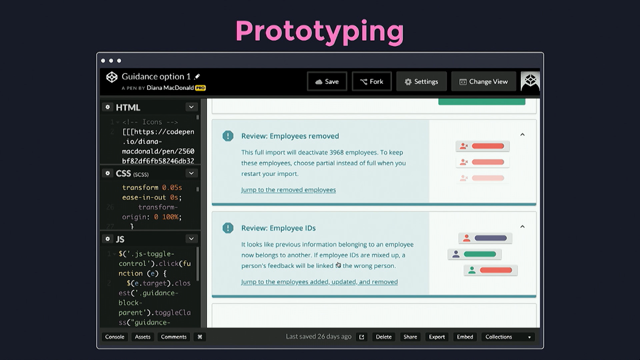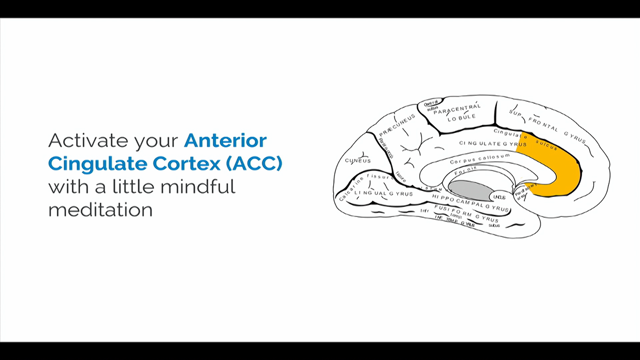Evolving an organisation’s culture through design

(upbeat music) - Hi everyone.
Thanks John, I was going to plug both those exhibitions, but John's done a fabulous job.
So you'll just have to hear it all again.
So I'm going to talk to you about how we're evolving the culture of ACMI through mostly UX design.
So I didn't actually have to come far.
So the museum is over in Fed Square, but we actually sit just behind the Art Centre at the Ballet Centre, in a co-working space called ACMIX. And a little bit more about me.
So before I worked at ACMI I was in London for five years working at Southbank Centre. So in a few digital roles there.
And then before there at Te Papa, the national museum in New Zealand.
So museums have always been my bag.
I think, like there's a lot of meaning in it for me. It's really important that I'm doing something that I feel very kind of passionate about.
But I'd always been interested to try the agency side of things.
So when I moved to Melbourne a couple of years ago I tried the agency side and I enjoyed the variety of clients and the different projects.
But I really felt like I couldn't affect change in the same way that you can when you're inside an organisation for a longer period of time.
So a little bit more about ACMI.
(dramatic music) So ACMI is the national museum of film, TV, video games, digital culture and art.
We have three galleries.
One permanent gallery exhibition and two temporaries. We have two cinemas screening independent and sort of more sort of foreign art house films. Two production and education studios.
A cafe bar and shop.
And each year we see around 1.4 million visitors come through the doors. And when I say visitors, I'll probably use it interchangeably with users.
And there's been a lot of chat about customers and all of that as well.
But yeah, visitors, are people that come to the space and then use us for our digital things.
So we've also got a brand new exhibition that opened last week which John has spoken about already. It's really beautiful, really immersive.
But I'll chat a little bit more about that later. So in 2015 we got a brand new CEO, so Katrina Sedgwick started with us.
And she also brought a whole new leadership team to the museum with a brand new vision.
So the new vision is for a whole new museum in 2019. And really exciting, two days ago our Minister Martin Foley announced that we've got full funding.
So we've got 30 million dollars to completely redo the whole museum, so it's full steam ahead for us and we are thrilled about it.
- [Man] Congratulations.
- So this is a quote from Katrina from last year. "In this rapidly evolving sector" "ACMI must become an organisation that is" "constantly evolving itself." "We must build an internal culture that is resilient" "and risk-taking active and accountable to ensure" "we remain relevant to our" "visitors and communities, so that we stay" "ahead of the curve, in content, process, and delivery." So this is basically the change that we're trying to make and why we need to do it.
So as part of the new leadership team Seb Chan came over from Cooper-Hewitt Design Museum in New York and he is our Chief Experience Officer.
And it was a newly created role.
So we're a very small team.
We're cross-functional, and you'll notice that there's no UX designer on the team.
We are all responsible for the user experience of the visitors and the users.
So we work across all the different departments in the museum to make sure that everyone is kind of thinking of the visitor first and the user first.
So a little bit more about the context of museums and the kind of environment that we're working in. So often museums are privileging artists, and auteurs over the visitors.
So that kind of has a legacy, and it also makes us work often in quite siloed ways. The moving image is now in everyone's pockets. So 20 years ago when the museum opened there were no smartphones.
It's a totally different world now.
So we really have to plan for that and a lot of this content you can just kind of access from your couch at home. So films, that kind of thing.
So we need to think a lot about what value we can add as a museum when a lot of this stuff is available to us all the time. So what value we can bring to visitors when they're at our museum, but also the value that we can bring to them when they're not with us. And as you know next door, if you've been to NGB, to the it's a great example.
But art is moving so much from content to experience. So it's much more now about just having this immersive, personalised experiential thing, rather than learning about the artwork and the kind of background of the artists.
And this is so important for us because so much of our content is very experiential when you think about VR and video games.
So a few challenges that we face because of this and many other things, we're not thinking holistically enough.
So we're not doing enough cross-team collaboration for problem solving.
And we're not thinking about the whole visitor journey. We're working in quite siloed ways.
So we're not giving our visitors the best offer, and the best service.
We have very low brand recognition.
So a lot of people don't really know what ACMI is or what we do, and they associate it with other things. So of the 1.4 million visitors that came to us in 2014/15, 40 % of them were just unintentional visitors. They didn't leave the house thinking that they were gonna come to ACMI.
They stumbled upon us because they were on a Fed Square or in the city and came into the museum.
So we hear a lot of things like, I went to the David Bowie Exhibition at Fed Square. Or I loved going to see a film at Murph at Fed Square. There's a real low appetite for risk in the museum internally.
People aren't comfortable with experimentation and failure. And if you remember back to Katrina's quote, that's something that she's really wanting to embed in the organisation.
The reason for this is because the previous leadership wasn't tolerant of failure.
And although there's a whole new leadership team, and you know probably 25% new staff since Katrina has started, it's really hard to shake that institutional memory.
Matching the pace of internal change to the pace of external change is really hard, and this is twofold.
So in digital culture, in moving image, it's moving so fast we can't keep up with it. But then the other thing is that our exhibitions, because they're so complex, they take two or three years to make.
So from the planning to actually the realisation, it really takes a long time to see those results. Internally there's a lack in transparency.
So around communications, information, and decision making, a lot of information is stored in Word documents on internal servers.
And because of the hierarchy of the institution, a lot of communications don't kind of get down to everybody. And importantly, the current design team sets in marketing, and they're not UX designers. They are strictly graphic designers and motion graphics designers.
So there's only been an emphasis on UX since Seb started. So we're at the very beginning of a very long journey. And lastly, I think the change that we need to make is ongoing.
It's never going to be finished.
It is constantly evolving.
And internally this is a real problem for staff. So it's internally, we try to define project ends. That's just like a really common thing.
So a film festival has an end date, and exhibition has an end date, and this really rubs up against the external culture which has no end.
We want visitors to keep coming back.
We want it to be a continual dialogue.
So here's a quote from Diana Rhoten, of IDEO. "There's no silver bullet or magic wand" "for big transformation, but there is design." "As designers we break down large-scale change" "into a series of discrete" "but interconnected acts that together over time lead up to" "new behaviours and opportunities." So this is exactly what we're trying to do at ACMI. And it's probably nothing new for you guys, you're all designers, which is great.
So museums are a great place and really exciting. And it's a great space for us to be able to test and experiment these sorts of things.
They're physical and architectural spaces, but they're also digital spaces.
Visitors come to the museum with an expectation of a type of experience, but they're very open to exploring something new. And they spend one or two hours in our building. So it's a great opportunity for us.
The value exchange is also time for experience. So it's not a strictly commercial exchange. So on to some examples of what we've been doing at the museum.
So we take every exhibition that we have is an opportunity to try some new technology and new user experiences in the galleries.
This here is an example of the Scorsese exhibition. So often there are a lot of stories that we want to tell that we can't fit into the four walls of the exhibition. So for this exhibition we had the opportunity to use some really fantastic interviews with Scorsese and some of his closest editors.
And instead of putting it into an audio guide that you had to like hire and then get the headset for, we noticed that everyone already has their own phones. So why don't we put our audio guide content onto your own phone.
So with this audio guide you could access it over the free Wi-Fi.
And also it means that you could get it at home, which is really important for us so that our content is reaching visitors when they're outside of the museum as well.
This was really successful for us.
20% is the general kind of take-up of audio guides in museums internationally.
And in the first month 58% of our visitors were listening to the audio guide.
So this is the trailer for the Terror Nullius exhibition that John mentioned.
So I'll just show it to you now.
- Greetings from the Hummungus, the Lord Humungus. The warrior of the wasteland.
The Ayatollah of rock and rolla'.
- [Man In Mask] Whilst this is a humanitarian and decent country, we are not a soft touch. And we are not a nation whose sovereign rights in relation to who comes here are going to be trampled on. (dramatic music) - So this is Soda Jerk's latest work.
And yeah, definitely you should come along and see it. It's free open until 1st of July.
So it's a 55 minute work as John mentioned. And we noticed with other video works that visitors were coming in to the work, they were walking through here, and then 20 seconds later they would walk out. And we didn't understand why.
So we talked to some visitors and found out that it's actually really hard to onboard people for time-based video work.
So people aren't sure when it starts, they don't know how long it's for.
They don't know what their in for because they can't see it.
So what we did was we just really simply mounted a digital timer, watch countdown, counts down from the work so that they know when they can go on.
So we haven't actually evaluated this yet 'cause we just put it in this week.
But this is an example of the kinds of things that we're trying to do at the museum to give people a better experience.
So we had a hunch that a lot of visitors might like some extra content from us.
So either if they can't come to the exhibition because they're not at ACMI, or in Melbourne. And also afterwards if they didn't kind of get to read it all or they couldn't kind of consume the whole thing, that they might like it on their commute home or at home later.
So what we did was we put the whole of the Del Kathryn Barton, The Nightingale and The Rose exhibition onto our website.
So in a long-form article and we kind of just notice that actually 10% of people got right to the bottom of the page, which really showed us that there was an appetite for this kind of content and it's informed a lot of our content strategy going forward.
Next up we did a light brand refresh a couple of years ago.
And the previous website really needed to be updated for like UX reasons.
People couldn't complete the main user journeys of just getting an event that they wanted to go to, and then booking a ticket and coming to ACMI. It was really problematic.
So with the new brand refresh we created a new website and we focused on those user journeys exclusively. So 80% of people, and what they needed to do, and we didn't kind of worry so much about the rest. So by doing this we actually launched a new website in five months, which was like insane.
And the results have been really fruitful.
And it just shows the importance of doing prioritisation. And yeah, using your kind of instincts around what users need rather than internal requirements. We thought that we'd extend the website project into the ticketing path because there were real issues. So we hit a lot of high numbers of password resets. A lot of people not being able to make transactions, and being really frustrated, and calling us. And it took seven clicks to book a ticket.
So like a $20 film ticket, seven clicks, like it was mad. So what we did was we looked at some different ticketing paths like Eventbrite that people are kind of used to.
Like good experiences in Shopify, and we streamlined our purchase path down to three clicks. It's been a real success for us for a lot of reasons, but mostly from a brand perspective like we've really built the trust back with our visitors.
We thought that we would actually extend this even further and we thought why don't we just use these tablets, give them to the visitor services staff, and they can be selling tickets on the go on, the floor at the museum, upselling membership, all that kind of thing? We had reopened the doors at Flinders Street and put in this lovely revolving door and people were flooding in. So we wanted to sell them tickets there rather than having to send them up the stairs.
It turns out that to get this done in time for the Wonderland exhibition opening, it was actually really problematic.
It would have been a huge amount of work to arrange it near the whole ticket path.
And if we'd used what we've built it would mean that our visitors would have had to actually type in their credit card numbers and their email address on their own, and it was a really bad user experience that would have lengthened the amount of time. And they could probably do it faster if they just went to the ticket desk.
So we built another ticket desk.
This is an example of things really not going to plan. We were imagining something very high-tech, and very cool and future looking.
People kind of walking around the museum with like ticket machines on their waists.
But yeah, it didn't kind of work out that way. But since the Wonderland exhibition has opened 40% of the walk-up visitors that haven't booked online have actually come through this ticket desk. So the need was definitely there.
The solution was just different to what we expected. So going back to Wonderland, I'm just going to play the trailer for this exhibition as well.
(soft music) - [Alice] Mr. Rabbit, oh Mr. Rabbit, I'm so late. Mr. Rabbit, if you please sir.
Oh Mr. Rabbit, come back please.
He must've went down.
Oh Mr. Rabbit, Mr. Rabbit! (techno music) There you are Mr. Rabbit.
Oh wow! (techno music) Just drink a little sip.
(techno music) - So the exhibition tells the story of all the different films that have been produced based on the book Alice in Wonderland.
And it's told through the lens of the history of visual effects.
So it takes us from very early cinema all the way through to CGI.
And we wanted the exhibition and everything to do with it to be magical, and surprising, and curious, just like the story.
So as part of the exhibition we developed a companion device and it's called The Lost Map of Wonderland. And it's pictured here.
So what it does is it unlocks surprises, and content, and objects around the exhibition using NFC technology. And it asks you to be curious and discover all the different things that are hidden in the map. It's not only for when you're in the museum at the exhibition, there's also a post visit experience.
So as well as people finding things within the exhibition, when they get home you can go a lot deeper into content that's related to the exhibition.
Watch a lot of the films, and read articles, and download your selfie that you took in the exhibition and all that kind of experiential stuff.
So all the last two years of work that we've been doing has really been leading up to this moment.
So we did some prototyping and usability testing with visitors to make sure that they knew what the map was and how they would use it.
And we can already see that without any prompts or promotion 10% of people that have a map are going home and using the website.
And half of them are getting all the way to the end of the site.
So we are just kind of going to optimise that now by sending out emails and doing promotions. So this is a really good metric for us.
It's been a real success story.
I think because none of us are UX designers by kind of trade, spreading these sorts of methods out throughout the rest of the museum.
So this is an example of a visitor journey map that we've put together for the testing for Wonderland, and all the different touch points that visitors will actually go through when they encounter the map.
It's been a great example of working collaboratively as well across all the different teams.
Yeah, it's come together very well.
As well as talking to our visitors we work really hard as well to improve the user experience for the staff at ACMI.
So the tools and technology that we have in the workplace, we really want it to be user friendly.
And for people to have a good experience when they're at work because then ultimately, the service that we offer our customers and visitors will be much better.
So we applied the same UX design approach when designing systems and processes at the museum. So as well as open plan offices like this one we also have open planned systems.
So we use tools like Trello and Slack, and they're really helping to break down the silos between the different departments.
They offer transparent communications, information, and reporting, collaborative by default.
And way more efficient than email.
These tools might not be new to any of you. But for museums to be working like this, it's really revolutionary.
So a few lessons, we've learned that visitors really love to help us with our products and services.
So going into the new museum design and build we're going to be using them much more.
Empathy and patience with staff goes a long way, but also with your visitors.
Change is hard, and it's slow, and it's never finished.
But I think particularly in these times of change, we have to be extra empathetic and patient with staff. But also persevere.
And I think for the change to be successful you need to have a shared and really well communicated vision to keep people motivated and excited about what's coming up next.
And UX design is a great way to help make this transformation happen.
So what's next for us? Building off Wonderland we're going to be spreading the UX design thinking across the museum much more. So we'll be doing many more design sprints and bringing in different teams that we haven't worked with yet.
We'll be thinking about exhibitions more as products and how we can design them and iterate on them as visitors encounter them like you would a digital product. So we want to be thinking about how we can improve the exhibition design by applying these methods much earlier on in the process, but rather than just when the digital part starts to be planned.
And also how can we improve the communication and project management of the exhibition development process.
With these ways of working.
We're looking to build up the internal skills and knowledge around UX design as we do this.
So developing staff skills through observational osmosis. Doing some observational design research workshops with RMIT, which have been really great.
And working on a UX playbook to share with people when they work with us on products.
But most importantly we are now all fully funded and ready to go.
So the first thing we'll be doing is getting started on this brand new museum for ACMI which will be visitor first, thank you.
(applause) (upbeat music)









